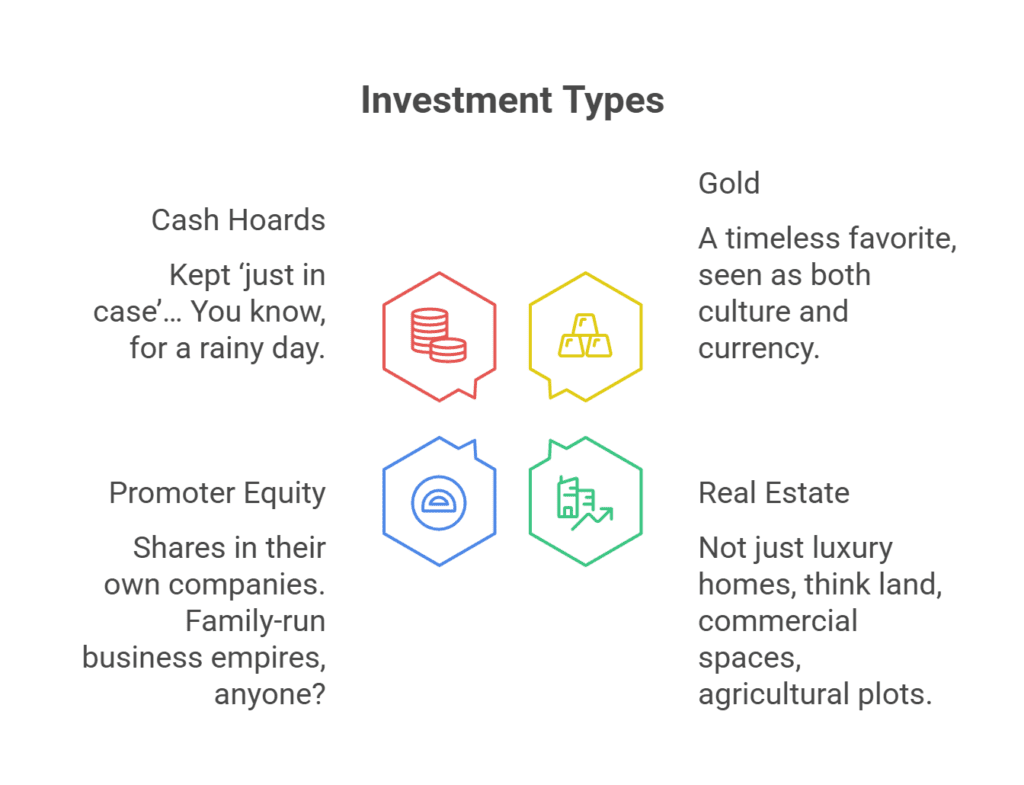Funny thing is, if you lived in India in the 1980s, you probably didn’t hear dinner-table stories about billionaire tycoons and private jets. Fast forward to today. Well, let’s just say wealth wears a sharper edge than ever before. The rich keep getting richer, headlines keep getting bolder, and numbers, well…they’ll leave you blinking.
Welcome to the world of India’s extreme wealth concentration in 2025.
The Shocking Numbers: Top 1% Own Almost Everything
So, what’s actually going on? Here’s the kicker: Just 1% of Indian households, yes, the proverbial “one percent”, now command close to 60% of the country’s total wealth. That’s not a typo. It’s what recent financial reports and several major studies emphasize.
Let’s break it down:
- India’s total household wealth is estimated at $19.6 trillion.
- How much the top 1% holds: $11.6 trillion (about 59-60% of the pie).
- Financial assets held by this 1%: roughly 70% of all of India’s financial wealth.
- Where they invest: Real estate and gold, mostly. Only a fraction goes into manageably “liquid” investments like stocks, mutual funds, or insurance.
And while all that may sound abstract, consider this: for every ₹100 in Indian wealth, ₹60 sits with the country’s richest 1 out of every 100 households.
Inside India’s ‘Uber Rich’: Who Are They?
Let’s peel back that curtain.
According to global research and wealth management firms, the ‘Uber Rich’ include:
- Ultra High Net Worth Individuals (UHNIs): Net worth above $12 million (Rs 100 crore).
- High Net Worth Individuals (HNIs): Net worth above $1 million, usually entrepreneurs, business scions, or legacy families.
- Affluent Households: The well-compensated professionals, industrialists, and old-money families.
Put together, this club is small, just 1% or about 35,000 UHNI families, but their impact? Staggering. Each UHNI household, for example, averages about $54 million (Rs 472.5 crore) in assets.
Where the Money’s Parked: The Love Affair with Gold & Real Estate

If you think India’s ultra-wealthy spend nights debating which tech stock to buy, think again. More than half of their assets are tied up in physical forms:
- Gold: A timeless favorite, seen as both culture and currency.
- Real Estate: Not just luxury homes, think land, commercial spaces, agricultural plots.
- Promoter Equity: Shares in their own companies. Family-run business empires, anyone?
- Cash Hoards: Kept ‘just in case’… You know, for a rainy day.
Here’s a twist: only about $2.7 trillion of the $11.6 trillion the Uber Rich hold is in “actively manageable” financial channels (like stocks, mutual funds, or deposits). The remaining $8.9 trillion? Tied up in assets you can’t move around easily.
The implications? India’s wealth management industry, bankers, asset managers, fintechs, faces both a challenge and a massive opportunity. So far, only a sliver (about 11%) of all those investable rupees are under professional management. That’s billions upon billions still waiting to be “financialized”.
Wealth Distribution: How Did We Get Here?
You might be wondering, “Was it always like this?” Not at all.
After Independence, and for the next few decades, India’s wealth gap actually shrank. But then, something shifted.
The Nineties Disruption: In 1991, India liberalized its economy, opening up to global trade, deregulating sectors, and attracting foreign investment. This led to explosive growth and, with it, explosive wealth creation. From barely one or two billionaires in the early ’90s, the country now boasts more than 270, a staggering increase.
Rise of the ‘Billionaire Raj’: Economic historians now argue that India’s current inequality outstrips even the worst of colonial-era divisions.
“In some ways, it’s worse than British rule,” claims one Mumbai-based financial analyst, referring to the depth and acceleration of inequalities in today’s India.
Distribution Breakdown in 2025:
- Top 1% owns: 59-60% of household wealth; 70% of financial assets.
- Top 10% own: 64-65% of all wealth.
- Bottom 50% owns: Barely 6.4%, a share that’s halved since 1961.
- Middle 40% (the “missing middle”): once commanded 43%, now down to about 29%.
Wealth at the very top is growing swiftly; for the bottom half, it’s kind of like scrambling for crumbs.
Income vs. Wealth: The Twin Gap
Not all inequality is created equal. Income (what you earn each year) and wealth (what you own, minus any debts) tell slightly different stories.
- Top 1% income share: About 22.6% as of 2023, highest since 1922.
- Top 10% income share: Over 57%.
- Income share for the bottom 50%: Just a sliver, barely more than 10%.
So, in both “what people own” and “what they take home,” the top is pulling further and further ahead.
The Human Side: What Extreme Inequality Feels Like
It’s easy to talk trillions. The real impact is much more personal.
Everyday Struggles
- Healthcare Costs: Every year, 63 million Indians are pushed into poverty because they simply can’t afford medical bills. That’s nearly two Indians every second.
- Unemployment and Underemployment: While the Uber Rich have multiplied their fortunes, job creation for the masses hasn’t kept up.
- Education Divide: Top private schools, legacy universities, and international degrees for some, underfunded, often overcrowded schools for millions of others.
- Gender Inequity: Women, on average, earn only about 63 paise for every rupee earned by male counterparts.
And believe it or not, it would take a minimum wage worker in rural India 941 years to earn what a top executive at a major company earns in one year. Sometimes, the gap is just mind-boggling.
The Rise of Indian Billionaires
There’s another twist: Billionaires aren’t just multiplying, they’re global powerhouses now. In 2023 alone, 94 new Indian billionaires appeared on global lists, second only to the United States.
Names like Mukesh Ambani (Reliance Industries), Gautam Adani (Adani Group), and Sajjan Jindal (JSW) are as famous as Jeff Bezos or Elon Musk. They shape, influence, and often dominate India’s business landscape.
What’s Driving the Gap?
It doesn’t happen by accident. A cocktail of factors fuels this chasm.
Economic Liberalization & Deregulation
Breaking open controlled markets unleashed a flood of entrepreneurship, big wins for some, but left many behind. Crony capitalism and the ease of doing business for the already rich have sped up the concentration at the top.
Tax Policies
India’s tax base is remarkably narrow: only about 1-2% of citizens pay income tax, leaving the government with less fuel for public investment. Calls for higher taxes on the ultra-rich, and for greater enforcement, have become louder, but face resistance from the powerful.
Stagnant Social Mobility
Educational inequalities persist. Top schools feed into top jobs; those with social advantages move up faster.
Asset Preferences
Cultural emphasis on gold and land, rather than liquid assets or innovation-driven investing, helps established families protect, and sometimes quietly grow, their wealth, away from easy measurement or redress.
Informal Economy
A large chunk of India’s workforce remains in informal jobs, low-income, no benefits, no safety nets, making upward mobility a pipe dream for millions.
Global Perspective: Is India’s Gap the Worst?
Short answer: It’s close.
Compared to Brazil, South Africa, and even the United States, India’s top 1% now holds a larger share of wealth and income. Some analysts say the level of disparity today is at its highest point in India’s post-independence history, and, yes, worse than under British rule, according to several major economic studies.
Rural vs. Urban: Double Divide
The wealth story isn’t just about “rich vs. poor.” It’s also “city vs. countryside.”
- Urban India: Home to most billionaires, industrialists, and corporate headquarters.
- Rural India: Still struggles with a lack of access to banking, investable assets, and educational infrastructure; agri-dependence limits wealth accumulation.
Migration to cities continues, but it rarely, if ever, translates to instant prosperity. Many find themselves in the informal workforce, trapped between opportunity and survival.
What About the Rest? Inequality in Daily Life
Let’s put faces to the data:
- A child in an urban slum, whose family spends most of their income on just food and rent.
- Farmers and manual laborers, whose earnings rise slowly, if at all, while crop prices and living costs climb higher.
- Small business owners, often hit hardest during economic shocks and are only recently recovering from pandemic-era losses.
- Young professionals, competing for scarce high-paying jobs, are often burdened with education debt.
- Elderly citizens, without adequate retirement savings or access to advanced health care.
Meanwhile, in the heart of Mumbai or Delhi, penthouses sparkle above city blocks, luxury cars zip past, and private jets wait for their next jaunt to Dubai or London. Parallel lives, same country.
The Debate Over Solutions
No quick fixes. But a roadmap is starting to emerge.
Better Taxation & Regulation
Economists, such as Thomas Piketty, among others, argue that India needs a more progressive tax structure and a full-scale wealth tax on the ultra-rich. The hope? Generate funds to boost health, education, and infrastructure spending.
Stronger Social Sector Investments
There’s a persistent call for more spending on health care, quality schooling, public safety nets, and nutrition programs for children, essential building blocks for broad-based prosperity.
Formalization of Assets
Encouraging the wealthy to choose managed, transparent investment avenues, moving some of that $8.9 trillion locked in gold, cash, and real estate, could widen access, create jobs, and fund innovation.
Data & Transparency
India’s economic data lags well behind global standards. Better access and reliability, especially for income and wealth, will help policymakers and citizens alike “see” where inequalities grow, and act against them.
Gender and Social Parity
Targeted programs to bridge the gender pay gap and uplift marginalized communities are essential.
Of course, all this is easier said than done… but public debate is only getting louder. Many believe the path forward is urgent.
Recap: Key Statistics at a Glance
| Metric | Wealth Share | Who Holds It |
| Household Wealth | $19.6 trillion | All of India |
| Wealth Held by Top 1% | $11.6 trillion (60%) | Uber Rich (UHNIs, HNIs, etc.) |
| Share of Financial Assets (Top 1%) | 70% | Same |
| Serviceable Invested Assets | $2.7 trillion | In stocks, MFs, and insurance |
| Non-Serviceable Assets | $8.9 trillion | Real estate, gold, etc. |
| Bottom 50% Wealth Share | 6.4% | Half of India |
| Number of Billionaires (2025) | 270+ | India |
| Average UHNI Household Wealth | $54 million | ~35,000 families |
Voices & Quotes
Sometimes, the sharpest truths need little embellishment:
“Half the country is fighting for crumbs while a tiny fraction lives in unimaginable luxury,” says one Mumbai-based analyst.
Or listen to Oxfam India’s blunt assessment:
“Seventy-three percent of the wealth generated in just one year went to the richest 1%, while 670 million poorest Indians saw only a 1% rise in their wealth.”
“Billionaire Raj” is the phrase scholars now use. And it paints a pretty accurate picture.
Closing Thoughts: Why It All Matters
Here’s the plain truth: The Indian economy is surging, and opportunities still abound. But the stark divide between “haves” and “have-nots” is both a social and economic risk.
In a world where private jets, marble-clad homes, and luxury cars are real for a few, while millions struggle to pay a hospital bill, wealth can feel less like a ladder and more like a wall.
But awareness, data, and open debate are pushing these issues front and center. The story of India’s top 1% isn’t just a headline. It’s a mirror, reflecting the choices a nation makes, and the futures it may choose to build, or change.








